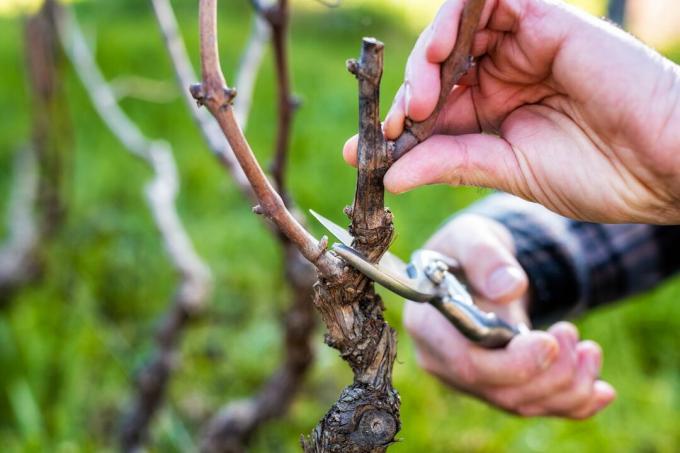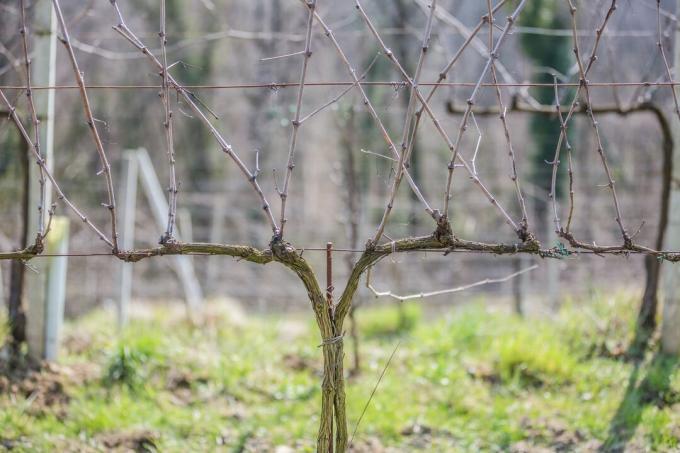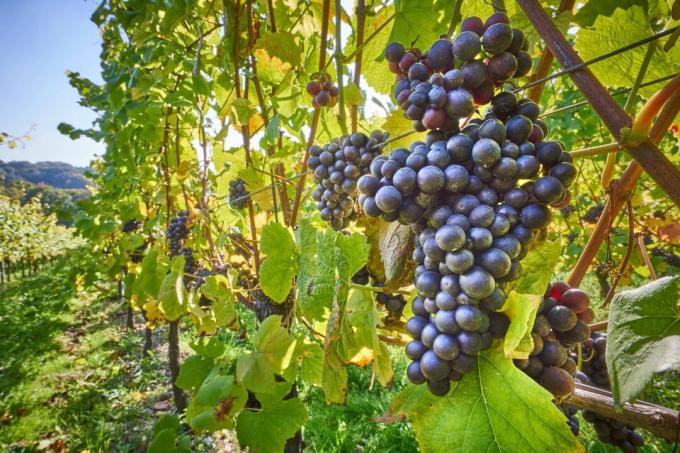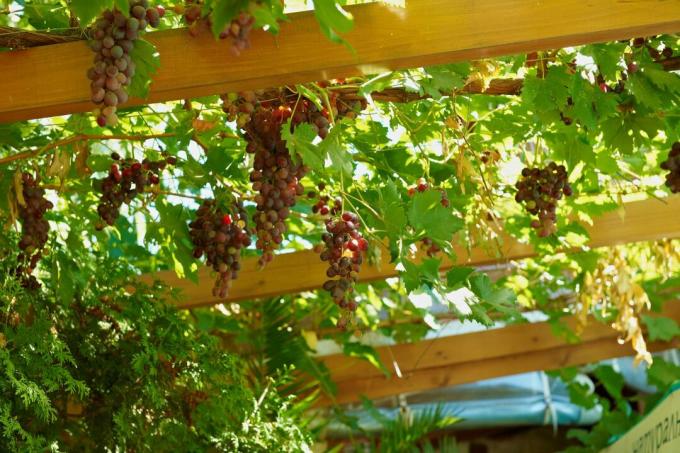Grapevines only ever bear fruit on one-year-old shoots. Regular pruning rids the vine of barren shoots and keeps it healthy. The vine thanks the care measure with aromatic grapes and high yields.

Pruning vines requires a lot of experience and the right approach. Laypersons often lack the courage to tackle pruning. The most common mistake is not to cut vines at all or too little! This article explains why, when and how to prune grapevines.
contents
- Do you have to prune grapevines?
-
When do you prune grapevines?
- Cut vines in the fall and winter
- Cutting vines in spring
- Cut wine in summer
-
Instructions: Cut grapevines correctly
- Cut old vine
- Pruning young vines
- Cut grapevine pergola
- Grapevine cut wrong: what to do?
Do you have to prune grapevines?
For a healthy vine that produces lots of tasty grapes, regular pruning should be done. Important reasons for pruning vines is good ventilation and light in the vine. This reduces the susceptibility of the cane to disease and increases the quality of the fruit.
What happens if the wine is not cut?
An uncut vine grows wild and quickly takes up a lot of space in the garden. It is difficult to tame and is putting down new roots elsewhere. Grape varieties are almost always grafted onto a phylloxera-resistant rootstock. The newly rooted shoots have been freed from the base and are therefore susceptible to the pests feared in viticulture. Because feral wine puts much of its energy into developing foliage and shoots, it produces fewer, poorer quality grapes. It also grows less densely, which is undesirable for a vine used as a privacy screen or shade provider in the garden.

When do you prune grapevines?
There are three time windows to remember when pruning vines:
- Winter: main cut (essential)
- Spring to Summer: Break out excess shoots
- Summer: Optional thinning

Cut vines in the fall and winter
The main pruning can take place during the entire leaf-free period from autumn to late winter. If the vines are proliferating, a later pruning is recommended, up to March depending on the climate. Old vines are better pruned in winter to encourage the plant to sprout more vigorously. In general, when choosing an appointment, make sure that the temperature is at least -5 °C.
With good training at the time of winter pruning, the vine has a strong trunk structure with many previous year's shoots that have grown together. A selection is made from these:
-
fruit wood: These are woody shoots that attach to the vine trunk. In the spring, the green, flowering and fruiting fruit canes emerge from this. Shoots that are supposed to bear fruit in the coming year are therefore shortened. Shortening all shoots to 1 or 2 eyes, the "cones", is suitable for beginners and is well tolerated by most grape varieties.
Medium pruning of individual shoots can also be considered for particularly vigorous young plants to prevent excessive foliage formation and increase yield. The fruit wood is left 3 to 5 eyes long. These longer "plugs" must be completely removed the following year after wearing.Tip: A long pruning to 8 to 12 buds is often practiced in vineyards. This cut is a bit more complicated and less suitable for beginners. With the short and medium pruning practices described above, good yields can be achieved in private cultivation.
- trunk wood: If desired, leave a few shoots as trunk extensions. They are used for the long-term structure of the hive and become the main structure over the years.
Cutting vines in spring
- From March and over the following months, it makes sense to break out shoots that have grown out of the fruiting wood pruned in winter and do not show any blossoming. Since they will not bear fruit, they should be removed.
- There are often still many fertile shoots left on strong-growing plants. Then it makes sense to select and leave only the strongest shoot with fruit set for each fruit tree. All others will be removed.
Tip for breaking out: As long as the shoots are still fresh and not woody, we recommend breaking or stripping them by hand at the base of the shoots. If you only find time to break out in the summer, a cut makes more sense due to the beginning lignification of the shoots so as not to damage anything.

Cut wine in summer
Summer pruning of wine is controversial and not absolutely necessary - reasons for this are:
- If there was no outbreak in the spring, it is essential to catch up in the summer.
- If value is placed on a neat look, for example with a vine trellis, the summer cut is often practiced. Disturbing shoots without fruit are removed.
- If a lot of foliage has formed that shades the grapes, "defoliation" in summer makes sense. Never remove all greenery at once to avoid sunburn. Instead, remove all the leaves around the grapes in several passes, which allows the fruit to ripen evenly and prevents fungal infestation.

Instructions: Cut grapevines correctly
In general, when pruning vines: always work with clean and sharp pruning shears to prevent infections and bruises and not to stress the plant unnecessarily.
Tip: If rough cuts are made for training, this measure is recommended in December so that the wounds do not bleed so much in the spring.

Cut old vine
The outlets on the trunk of an old vine are bulging after the many annual cuts and are therefore less willing to grow. It's time to taper off to a near-trunk, upright water shooter. This can be done as follows:
- A vertical water shooter is left standing. If none is available, a kerf cut can be made. At the desired location, a crescent-shaped notch is made above a selected bud, extending into the woody body of the shoot. In this way, the underlying bud is stimulated to sprout by an accumulation of juice and hormones.
- In the following year, the shoot is lignified and can be shortened to the desired trunk height during winter pruning.
- To be on the safe side, leave the stock with two trunks for another year.
- In the third year, the old stem can be removed.
In order to promote more vegetative growth of the old vine, nitrogen fertilization in spring is recommended. Our Plantura organic universal fertilizer consists primarily of purely organic, plant-based raw materials and offers the ideal nutrient composition to supply your vines. Sufficient nitrogen promotes growth and leaf formation. A high proportion of potassium and phosphorus also optimally supports your plant in the development of flowers and fruit.
Pruning young vines
The training pruning of a young vine takes place over several years:
- 1. Year after planting: The tall, grafted shoot is now lignified. It is later shortened to the desired height of 60 cm for the strong trunk of the vine in March, or even more for espalier vines. The shoots of the upper two eyes are left for the development of fruit canes in the coming year, all others are broken out.
- 2. year: One of the two shoots left in the previous year is shortened to 6 - 8 eyes and the other to 1 - 2 cm long cones. The longer shoot is bent and tied to the trellis wire - it will produce the first grape harvest this summer.
- 3. Year: Two young shoots growing from the cone are bent and tied to the lower trellis wire - they will produce fruit in the coming year. The removed fruit wood shoot of the previous year is completely removed. In addition, one of the remaining shoots is selected and cut for tapping so that the following year's fruit canes can grow from it.
- 4. year: Optionally, by leaving a shoot as trunk wood, you can extend it to the second load-bearing level. This approach allows individual growth forms to be created over the years.

Cut grapevine pergola
Cutting vine to pergola can create lush and shady green roofs. The trunk is run parallel to the support pillar and the branches are set up 15 cm apart. In the first few years they are pruned to short cones, later you can switch to medium pruning if a higher leaf density is desired. Depending on the size and width of the object, greenery can be planted from two sides. It is also possible to grow stocks with two parallel vine trunks about one meter apart on the roof.

Grapevine cut wrong: what to do?
As long as the grafting point, which is visible as a thick bulge on the main trunk, has not been injured, nothing is lost! Old vines can be cut back radically, they usually sprout again. A stick can even be cut back to the trunk and then reared again.
Very old vines, however, are less keen on growing and will never green a facade lushly or bear healthy fruit. In the case of a vine that has been pruned incorrectly for many years or is very old, it makes sense to to assess existing willingness to grow or initially by a growth-stimulating cut in winter testing. The new one comes accordingly Planting a grapevine into consideration or you can find out how to use the right one vine fertilization create the best growth conditions for the vine after pruning.

Grapevines are heat-loving plants. In harsh locations, the frost tolerant mini kiwi be an exotic but easy-care alternative to greening facades or pergolas.


